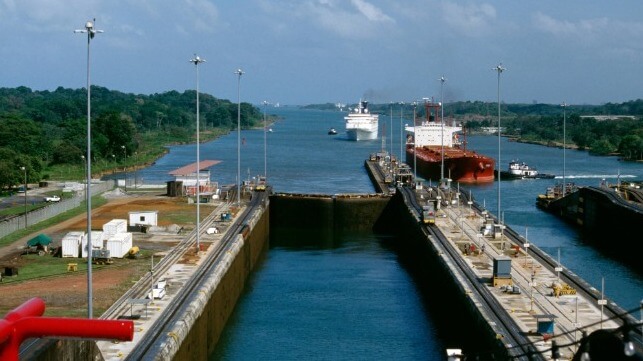Near Miss Reignites Debate on the Panama Canal

A video that shows a POST-PANAMAX containership crowding a tugboat towards a closed lock gate on March 5 has reignited the debate over safety on the Panama Canal. Voices in the background express shock as the tug, which carries a five-person crew, comes perilously close to being crushed under the bow of the massive vessel. The video was posted anonymously to social media shortly after the incident took place.
“The locks were not ready, the chamber was not full, and the gates were closed, but the pilot went ahead anyway,” said a tugboat captain who asked that his name not be used. “A tug at the stern is a requirement to go through the locks, but there was no stern tug because the pilot did not want to wait for the second tug, which was with another vessel.”
The MM&P affiliate Unión de Capitanes y Oficiales de Cubierta (UCOC) represents tug captains and associated vessel personnel on the Canal.
The tug captains say the March 5 close call was a consequence of the Panama Canal Authority’s decision to loosen safety procedures.
“Nothing is written down,” one said. “There are no safety procedures so pilots can do whatever they want. Two weeks ago, a pilot decided to enter the locks without a deckhand crew. Some of the pilots appear to think that they have the prerogative to enter the locks without stern tugs or line handlers and to travel at unsafe speeds through the Canal. We live in anarchy here.”
Panama Canal workers are being forced to perform their jobs under increasingly hazardous conditions, and the situation puts the world’s supply chains at growing risk, MM&P and UCOC have warned. The most recent incident could have been fatal to the tug crew and seriously damaged the lock gate.
The hazards stem mostly from the poor design of the expanded Canal, which has given rise to a much more labor-intensive process of vessel transit. In the old locks, electric-powered locomotive “mules” run on tracks along the sidewalls, using mooring wires and tension winches to maintain the position of transiting ships.
In the new locks, tugboats are required to continuously position vessels in transit. This puts great strain on the tugboat operators who are at the controls of their tugs throughout the entire transit, often for many hours without relief. Internationally recognized hours-of-rest standards are being routinely ignored by Canal management.
And there is no room for error. The lock chambers are 1400 feet long. Ships of up to 1215 feet in length are approved for transit in the new Canal. Each of the two tugs averages 90 feet in length.
Equipment shortages and cost-cutting are sharply increasing the danger. The Canal Authority says it has 46 tugs, but many are so old that spare parts are no longer available, and they are no longer maintained.
The risks to safety are severe and growing. A fire broke out aboard the tugboat Dolega in the vicinity of the city of Paraiso on Feb. 14.
A video filmed in August 2022 shows an aging tug lose steering and propulsion in the Miraflores locks and strike one of the locomotives that run on tracks along the walls of the chambers. “The Panama Canal Authority has allowed conditions to deteriorate to the point that it is only a question of time until disaster strikes,” says MM&P President Don Marcus, “and a crisis has the potential to impact international trade to an extent far greater than the grounding of the M/V Ever Given in the Suez Canal in March of 2021.”
"Unlike the situation in the Suez Canal, which is simply a ditch, if a single Panama Canal lock gate were to be breached, it would take months to repair and, in the meantime, the Canal would be closed to all NEOPANAMAX vessels.”
“Immediate action is required.”
No comments:
Post a Comment